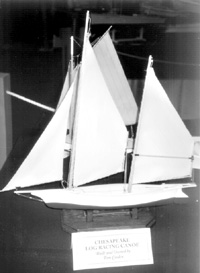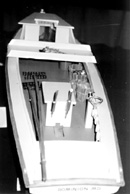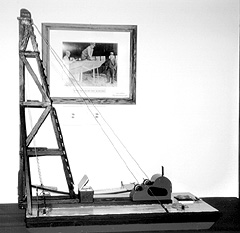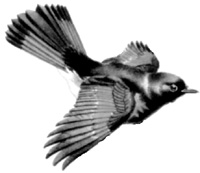
Dock of the Bay

Volume VI Number 38
September 24-30, 1998
Model Boats Reflect Bay History
photos by M.L. FaunceChesapeake
log racing canoe, built by Tom Cosden; Chesapeake oyster boat built by Joseph
DePietro; a pile driver by Bobby Bast.
Featuring models of boats that sailed and worked the Chesapeake Bay, both from days gone by and present times, this year's annual fall exhibit at the Captain Salem Avery House doesn't fall far from the tree.
"Appropriate for the area," George Daly, the exhibit's director and co-president with his wife Mavis of the Shady Side Rural Heritage Society, modestly calls the special show of craftsmanship. The appropriateness of the subject matter at Sept. 20's opening reception was everywhere in sight. You saw it in the turnout by local watermen, in the owners and model builders who spoke about their collection like love affairs, in the sweeping views of the West River just outside this restored waterman's home turned museum.
 We saw, too, that the
heritage of the Chesapeake Bay is alive and well preserved in the skillful
hands of these craftsmen. On exhibit are bugeyes, buy-boats and batteaus,
log canoes and poundnet skiffs, schooners and skipjacks, workboats of all
kinds, a huge pond boat, draketails and dredges and a few warships. Lest
you think the exhibit is all work and no play, a varied and rich collection
of recreational and racing sailboats fills out the show and adds keen competition.
We saw, too, that the
heritage of the Chesapeake Bay is alive and well preserved in the skillful
hands of these craftsmen. On exhibit are bugeyes, buy-boats and batteaus,
log canoes and poundnet skiffs, schooners and skipjacks, workboats of all
kinds, a huge pond boat, draketails and dredges and a few warships. Lest
you think the exhibit is all work and no play, a varied and rich collection
of recreational and racing sailboats fills out the show and adds keen competition.
Lilliputian though the scale model boats are, the dreams and schemes of their creative carvers are Brobdingnagian. Prolific Joseph DePietro of Chester brought a full flotilla of Bay craft to the museum.
He builds his model workboats without plans, using only photographs as
his guide. He made his Valerie E. Faith, a deadrise workboat, entirely from
scraps of an old screen door. Miniscule oysters sit ready for culling on
the Lil Creeker III, as if just harvested from the Bay's bottom. Miniature
baskets are brimming with oysters, too, and hand tongs lie at the ready.
These models aren't just fabrications, they are made faithfully after real
boats that ply the Bay still.
Take Tom Cosden's models: traditional Hooper Island draketail and Chesapeake log canoe, to his "Cry Baby" runabouts and utility racing boats that hide tiny engines. From teensy dinettes, port-a-potty and stoves, no detail is unimportant. These boats are ready to rock and roll with the tide and times. Cosden, of Lothian, designed the "real" boats as well.
Get a lesson in local sailing with local sailing craft. Back in the 1930s, Dick Hartge of Galesville came up with his own answer to the competitively designed New England sloops. He launched a new class of sailboat especially designed for the West River. These were Chesapeake 20s with their wide rounded underside. After several transformations from the Albatross to the Seawitch to the Defender and finally the Ranger, the 20-foot open class boats still compete today. Admire several models of Chesapeake 20s in this show.
The exhibit is a who's who of names well known in Chesapeake Waters: Hartge, Leatherbury, Nieman, Bast and Rogers. To that company, we're glad to learn add Bergling, Starry, King, and other owners and builders.
The small craft continue on display at Captain Salem Avery House and Museum in Shady Side from 1-4pm Sundays through Oct. 25: 301/261-5234.
-M.L. Faunce
Pondering septic systems may not rank high on everybody's list of ways to spend an Indian summer Saturday, but then again, when do you make such a date? Do we wait until all systems fail?
That day's already come for many of the 350,000 Marylanders who rely on the good earth to purify their wastes.
"There are thousands of failing septic systems throughout the Bay watershed which release improperly treated effluent into ground water and waterways," says Ann Pearson of the Alliance for Sustainable Communities.
Worse, fixing them will cost, according to Jay Prager, Maryland Department of the Environment's man on wastewater, between $3,000 for a traditional septic field and $12,000 for an "innovative" system that filters household sewage through sand, shale or clay aggregates.
So the 150 or so who joined the Alliance's Sept. 19 Roundtable on Sustainable Technologies were banking information for a not-so-distant rainy day. On that Indian summer Saturday, they heard and debated strategies that reached from their own backyards to the vast Chesapeake watershed.
You could, in other words, put your thinking into somebody else's contribution to the Bay's nitrogen problem - like those chicken farmers in Delmarva - or your own.
Most of us don't readily dwell on what's happening in our own backyards. "Our attitude to waste has been out of sight, out of mind," said David Del Porto of the Massachusetts engineering firm, Sustainable Strategies, echoing a conference theme.
Nearer to home, Prager agreed. "Who do you know," he asked rhetorically, "who's going to go to their county health department saying, 'I want to make sure my septic system is efficient as it can be. Will you come and take a look at it'?
"People only go to the health department if their system has failed. Yet that's the first step in most counties to improving your septic system. Maybe," Prager mused, "that's an obstacle. Maybe we should be providing incentives."
Caught between a stick and no carrot, most of us do nothing until we must. In Massachusetts, the day of reckoning comes, by law, when a homeowner wants to sell. No approved septic system, no sale.
Anne Arundel County, on the other hand, is what Prager called "mortgage driven." You don't have to do a thing until you want to sell and not then unless the purchaser's bank insists on a septic assessment. The other check and balance is the county's permitting system. Any building permit requires a septic system evaluation.
Conference goers learned more than you want to know about sticks.
Yet there were carrots. Del Porto's depiction of a fully sustainable septic system was so elegant that it made poetry of poop. Here's what you could do - and others have done:
"Grow your problem away" with a closed system that screens out the waste and reuses the rest. In such a system, there's no real waste except perhaps the lint from your washer. Even the wastes we like least to think about, excrement and toilet paper, can be turned to good with a compost toilet. Don't scoff. "Porcelain, low-flush compost toilets are being built into upscale homes," says Del Porto.
Aside from that bit of "black water," almost all the other wastes that tax your septic system and supercharge the Bay - the average septic field produces 1,800 pounds of nitrogen on a per-acre equivalent, we learned from Margaret Maizel of NCRI Chesapeake Inc. - are "gray" and immediately useful.
Imagine a washer that could turn one wash's rinse into the next load's wash. Don't stop there.
Imagine a bamboo garden, a greenhouse, a field of lilies. Such joys as those are the reusers in the kind of sustainable system designed by Del Porto for homeowners, fire departments, businesses.
"We can and do design such systems for a price usually equal to or lower than conventional systems," said Del Porto. "In balanced ecosystems like these, there is no waste. It's all food. Pollutants become beneficial nutrients."
In California, Florida, Massachusetts, such systems are more than dreams. They're carrots. Here in Maryland, we've got sticks - and failing septic systems.
Learn more from the Alliance for Sustainable Communities: 410/956-1002.
-SOM
At the coming of the new millennium, Marylanders
will have a little something extra to celebrate.
For the first time in history, Maryland will be commemorated on the quarter. Our own quarter, to be minted and issued in the year 2000.
The U.S. Mint is commemorating each of the 50 states with customized designs on the back of the quarter. Over a space of 10 years, five states per year get their special issue quarter minted in the order they were admitted to the United States. The first five - Delaware, Pennsylvania, Connecticut, Georgia and New Jersey - have already submitted their designs. Their coins come out next year. Maryland, as the seventh state, gets its customized pocket change at the turn of the century.
As with the 1976 Bicentennial quarters, the commemorative state quarters will be circulated normally, not minted as special order collectors' coins.
"The U.S. Mint will coin 500 to 700 million quarters for each state, depending on demand," says Michelle Byrnie at the governor's office. The coins for each state will be circulated nationwide.
Where you, the creative public, come in is designing the coin's tail side. Entries have already been submitted, including many "beautiful designs sent in by graphic artists," says Byrnie. But the door isn't closed yet.
Even if your artistic skills aren't quite up to par, no worry. "It doesn't have to be a finished design. It's really the concept that's being looked at," assures Byrnie.
After the five finalist concepts are chosen by the Maryland Commemorative Quarter Design Selection Committee and approved by the U.S. Mint by February 1999, the big winner will be chosen by the governor and submitted by April 29. Back at the Mint, artisans polish up the winning design and create the finished coin art.
Feeling creative? Here's the rules:
What do you get if your concept wins out? A quarter.
"I imagine we'll hold a press conference to introduce the person who came up with the minted design, but there's no cash reward or anything like that," says Byrnie. "Just knowing that your design was picked is the reward."
Submit designs before Fri. Oct. 2 to: Commemorative Quarter Design, Office of the Governor, State House, 100 State Circle, Annapolis, MD, 21401: 410/974-5258.
-Mark Burns
Who's Here -- All that Flutters Is Free
Sit long enough and the glories of Indian summer
are yours. The scene outside my door (and yours) is a changing diorama of
color as nature forges on to another season. Just when we need a change,
color is now nature's gift for us.
Transitory visits by creatures small and smaller sweeten the pot. Some visitors are so fleeting that even a trip to the post office will postpone the chance meeting for perhaps another season.
Such is life, of course. We take our chances as busy days somehow grow into long lives where we snatch scene of the seasons and particles of poetry when and where we can. Which is how I glimpsed the American redstart I've never seen before in Maryland but often have in Maine, up in true warbler country.
The sparrow-sized redstart prefers wood, swamp and orchard - the essence of Bay Country once if not now. You, too, will recognize this diminutive warbler if you chance on one this fall: it's a glossy black with striking orange or salmon patches on wings and tail and white underside.
From my deck I watched its characteristic flutter of wings against a backdrop of a turning maple tree. For all the colorful swirling, the bird might have been a falling leaf. But this is not nature's camouflage, just nature's tribute to a painter's palette as autumn approaches. The migration is in motion and this merry midget is just passing through to winter in states and countries to our warm south. How smart.
As the tupelo turns and the maples sugar-up, I caught just one act in the fleeting seasonal migration. As fall colors flame and flicker, let New Bay Times know what flutters past your home in Bay country.
-M.L. Faunce
In Virginia, Gov. James Gilmore asserted last week that his state won't become the "home of New York trash" even though he received $100,000 in garbage campaign donations. A few hours later, Waste Management Inc. sealed a $133 million contract to increase the two million tons of trash buried in Virginia yearly, adding to the state's dubious distinction as the second biggest waste importer in the nation ...
Oregon motorists were noticing an awfully lot of squashed toads on a highway near the town of Sunriver. Turns out that the toads were trying, not too successfully, to hop between two of their breeding grounds. But a solution jumped into someone's mind: A local Toad Patrol has strung drift fence along the road which funnels the toads into buckets, which are then carried across the road
In New England, those bigger, faster
whale-watching boats have stirred a controversy. This month, a minke whale
was killed by one of the boats, and last month a humpback was injured in
collisions with the big boats. Now the government is considering new regulations
that would keep the boats farther from whales. the Boston Globe
reports
In Alabama, a environmental group called Mobile Bay Watch is toasting its newest member with margaritas. He's none other than singer Jimmy Buffet, who said he wants to work toward balancing economic growth with a healthy environment ...
Our Creature Feature this week comes to us from Washington D.C. and it concerns two: the political animal and the fish.
You might know Rep. Dick Armey as an archconservative Texas Republican who doesn't give hoopty-do about the environment. It turns out that he has a redeeming quality: He's a fisherman.
But in Armey's eyes, some fish are more equal than others. In fact, when he catches a bass, he kisses it, he confessed last week. He doesn't show the same affection to catfish. Said Armey in words that belie his Ph.D.: "I ain't going to kiss no fish with whiskers."
| Back to Archives |
Volume VI Number 38
September 24-30, 1998
New Bay Times
| Homepage |